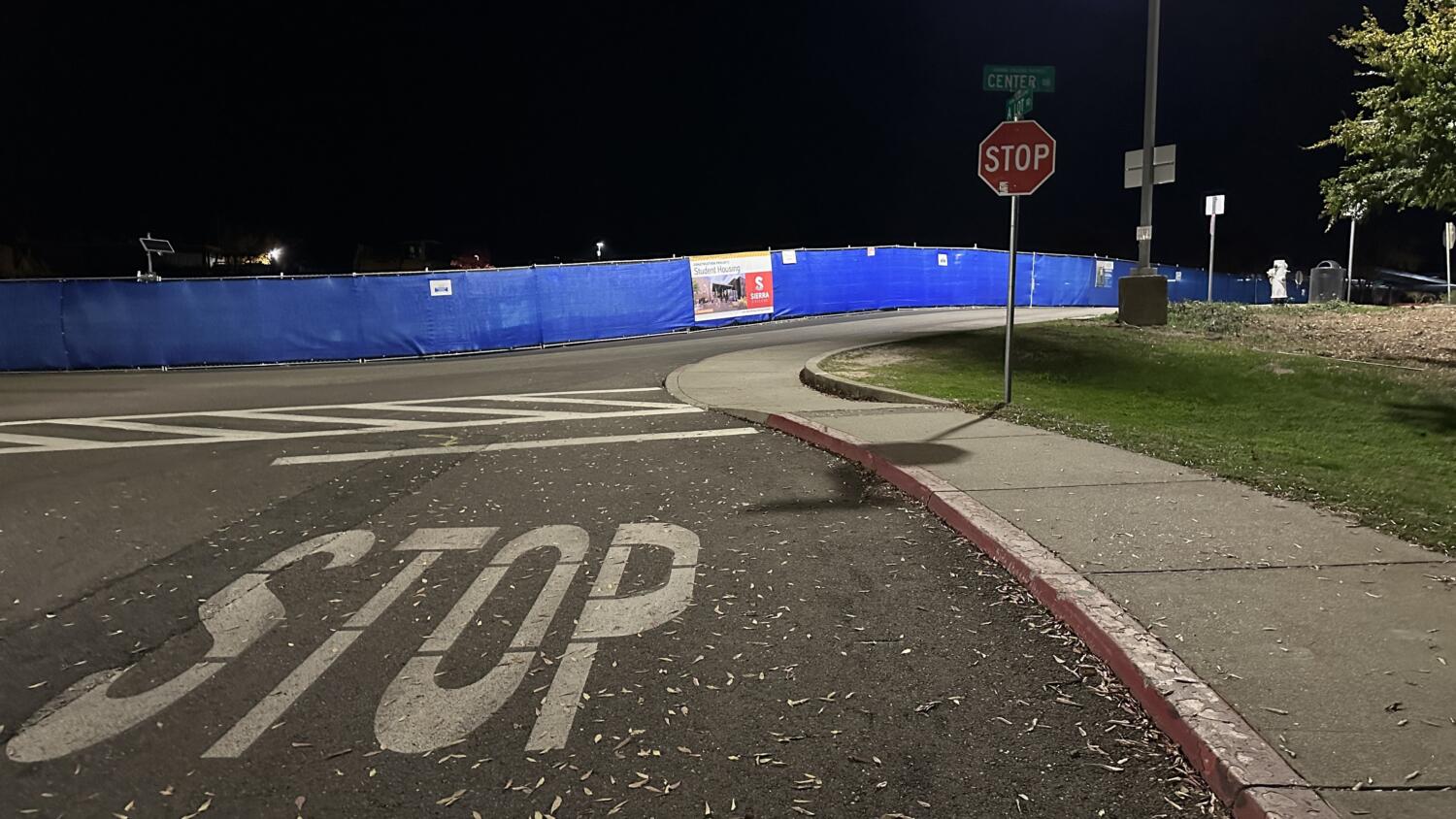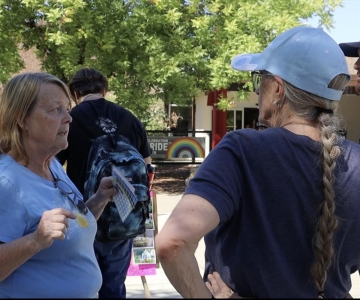When a new semester of college begins students everywhere deal with a familiar problem: a lack of parking. When the Fall 2023 semester began at Sierra College’s Rocklin campus, students were faced with the same problem, but this time with a twist. Large swaths of student parking were off-limits due to construction.
Hundreds of prime parking spots gone, seemingly without warning, and little explanation.
Many students found themselves parking in the far-reaching H and I lots, areas typically known for hosting weekend used car sales. Adding potential injury to inconvenience, much of the pathing from the distant lots was rendered inaccessible, leading some to walk alongside vehicle traffic to get to class. The dance of pedestrians and cars as they competed for space on Campus Drive had begun.
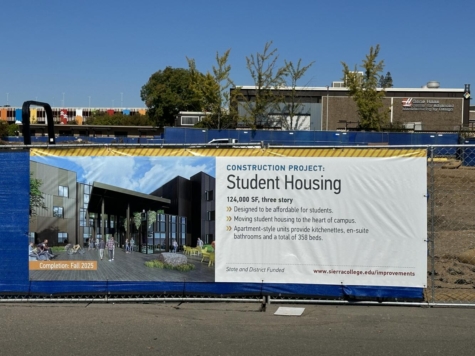
The question many students undoubtedly had on their minds other than, “is that car leaving?” was “what happened?”
The answer is simple enough. Sierra College is building new student dorms in the place of some parking spaces. Once completed, Sierra’s new dorms will add 358 beds to current on-campus housing. Because it’s being primarily funded by California’s Affordable Student Housing Program, Sierra College estimates that it will be able to charge rents at about half the local market rate.
However, many students being impacted by the dorm construction will not reap its benefits. The nearly $100 million dollar project is scheduled to be completed in the Fall of 2025, well after many current students have transferred to four-year schools or otherwise completed their time at Sierra.
In our October 2023 interview about the construction, Sierra College student, Anna Martinez lamented the impact that construction was having on parking. She said,
“It’s frustrating, especially when a semester pass to park is like $70 this semester.”
Martinez tied the cost of parking to the ongoing construction when she said, “I feel like I’m not getting my money’s worth with all the noise and less access.”
The Cost of Parking at Sierra College
Student fees, including parking, at California community colleges are overseen by the California Community Colleges Chancellor’s Office (CCCCO). For the 2023 – 2024 school year the most a school can charge for a Spring or Fall semester parking pass is $70.00. The shorter summer session has a lower limit of $34.00.
Of the 117 California Community Colleges (CCC), 116 of them have parking available; the online-only Calbright College has no campus. Based on my November 2023 analysis of each schools’ fees, the average cost for a semester parking pass is $30.23 for Spring or Fall, and $17.49 for Summer.
Sierra College charges the maximum for parking, one of only three CCCs to currently do so.
It’s also worth noting that Sierra faculty and administrators receive free parking on campus. Student employees, on the other hand, must pay to park on campus for work despite earning a fraction of their faculty and administrators coworkers.
The issue of paying the state maximum price for parking came up during my November 2023 interview with Sierra College President, Willy Duncan. When I asked about why Sierra is an outlier in how much it charges for parking, he indicated that he wasn’t aware that so few schools charged the max.
Asked if giving students a parking discount during construction was considered, President Duncan stated that the administration “… haven’t talked about reducing the price or doing something like that just because as long as there’s sufficient parking in place, I don’t know that it really changes anything.”
For some, Sierra’s parking fees may still seem reasonable, but for others it’s just not worth the cost.
Sierra student Lauren Platte stated that she’s skipping paying for parking altogether. In our early October 2023 interview, she said “It’s a sacrifice some people are willing to make, but for me, I didn’t really want to pay $70 if I could just get here a couple minutes earlier and walk.” Instead, Platte parks in a non-school lot across busy Rocklin Rd, a cost saving measure that she estimated to be a ten-minute walk.
Parking Paying for Parking
Given the comparatively high cost of Sierra’s parking one may wonder where the money goes.
In my October 30th 2023 interview with Erik Skinner, Sierra College’s Assistant Superintendent Vice President of Administrative Services, he explained that the money students pay for parking goes towards the cost of maintaining and repairing the parking lot infrastructure. He stated that the fees collected don’t “…come close to covering what the true costs of that are.” Skinner added that parking revenue is also what pays for the security in the lots.
President Duncan echoed Skinner’s point, but added that Sierra has “… to put general fund dollars, money that the college brings in from the state [towards the] maintenance we do on an annual basis,” in addition to utilizing money collected via parking fees.
Perhaps surprisingly, parking fees are not what paid for the $49.9 million dollar 1,501 spot parking garage that opened on Sierra’s Rocklin campus in July 2021. That was funded via Measure E, a $350 million dollar facilities bond passed by voters in 2018 that is the money behind several completed, and future, campus construction projects.
Sierra’s new parking garage will eventually require maintenance though, which will be paid for, in part, by Sierra students when they purchase parking permits. Continuing the cycle of parking paying for parking.
Concerns regarding parking cost aside, the garage has had the benefit of adding significant parking capacity in time for the dorm construction.
As President Duncan stated in our interview, the garage has yet to hit maximum capacity during the Fall 2023 semester. And in those cases when the garage does get close to capacity, he added that “… we always have parking in some of the different lots. They may not be everybody’s favorite. K lot is a bit of a walk, but there’s always parking in K lot.”
The Parking Hunt
If Sierra has so much parking, why the frustration with finding a spot? Much of that likely comes down to the change in parking habits necessary on the part of students not already accustomed to parking in the garage.
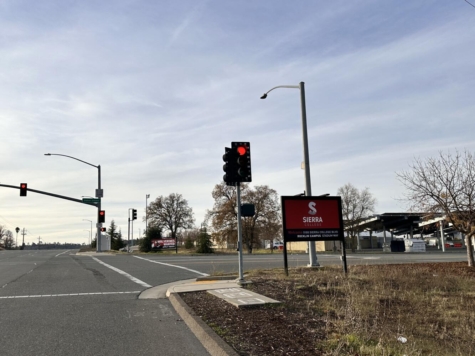
Sierra parking is divided into two separate areas that remain isolated from one another. The parking garage along Sierra College Blvd., and the surface parking lot along Rocklin Rd. If a student fails to find desirable parking in one, it is neither quick nor easy to access the other depending on traffic.
While the parking garage occupies a prominent place in Sierra College’s skyline, how to access it may appear unclear to the uninitiated. There is a lack of signage along Sierra College Blvd. indicating where the entrance to the parking garage actually is.
In our interview, Skinner indicated that Sierra’s administration is always looking at ways to improve the student experience and is open to feedback, but that the single road entrance via Sierra College Blvd. was intentional. “The facilities master plan is to try to address the traffic problems and backup that can occur on Rocklin Rd. for students coming in off of 80.” He added that the desire is to: “… encourage more utilization of the Sierra College Blvd. exit. That path of travel is more modern. It’s wider. It can accommodate the traffic better.”
The Cost of Free Parking
The Community College League of California issued a report in 2021 titled Addressing Affordable Transportation Needs that looked at the cost of students getting to school, including paying for parking. The taskforce that created the report, which included Skinner, states that “It is time to fund campus safety staffing and facility maintenance appropriately. This change would allow colleges to reduce or remove parking fees, eliminate dependence on parking citations as a revenue source, and be more creative in spending necessary resources on support for students and not enforcement.”
While free parking sounds appealing, there are downsides.
One potential issue is creating induced demand for parking. Induced demand is the phenomenon of consumption increasing as something becomes more affordable. It’s what happens when more lanes are added to a freeway but traffic gets worse as more people are drawn to the promise of less traffic.
In addition to the impact free parking could have, there’s potential problems with adding even more parking. President Duncan stated during our interview that the original plan was for two parking garages to be built, but that idea was scrapped. “I’d really rather us to look towards alternative types of transportation to meet the needs…” President Duncan concluded.
If parking is free and abundant will it cause more people to drive to campus instead of using alternative methods?
No Single Solution
The solution to Sierra’s parking problem is not as simple as making parking free and adding more of it. Instead, the solution lies in a series of actions that individually would appear to have little effect, but will ultimately make getting to campus both more affordable and less frustrating for students. As President Duncan said near the end of our interview,
“It’s gonna take a lot of different things, a lot of different solutions to meet everybody’s needs.”
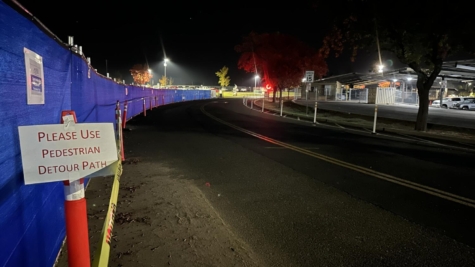
Administration should re-examine the policy of charging the maximum for parking fees. If 97% of other schools in California can charge less, why not Sierra? A discount during construction, as well as relief for low-paid student employees, should be at least considered.
Until that happens, students with the California College Promise Grant can take advantage of significantly discounted parking rates.
Students frustrated with construction in the Rocklin Rd. lots should consider using the parking structure instead. The interactive campus map in the Sierra App, and on the Sierra website, offers real-time pathing for anyone afraid of getting lost.
Better yet, one can forgo paying for parking altogether by getting a free bus pass with their Sierra ID.
Biking to campus is another option, one that Sierra could do more to incentivize. For example, Lane Community College in Eugene, Oregon has a bike loan program that offers students a free bicycle and accessories. Closer to home, Santa Monica Community College gives monthly payouts to employees that use sustainable transportation, including cycling, to get to school. Though, the program is only offered to employees at the moment.
Some solutions to Sierra’s parking problems are easier, and cheaper, than others. After all, in the weeks after the Fall semester began, simple pedestrian signage and a roped walking area were added along Campus Drive. The sight of pedestrians and cars intermingling has been all but eliminated.
The simplest, and arguably most important, thing students can do to improve the parking situation at Sierra is to speak up. Sharing concerns and ideas with school administrators and student representatives is free and can help affect both short and long-term change.
Written, Reported, and Photographed by Greg Micek

